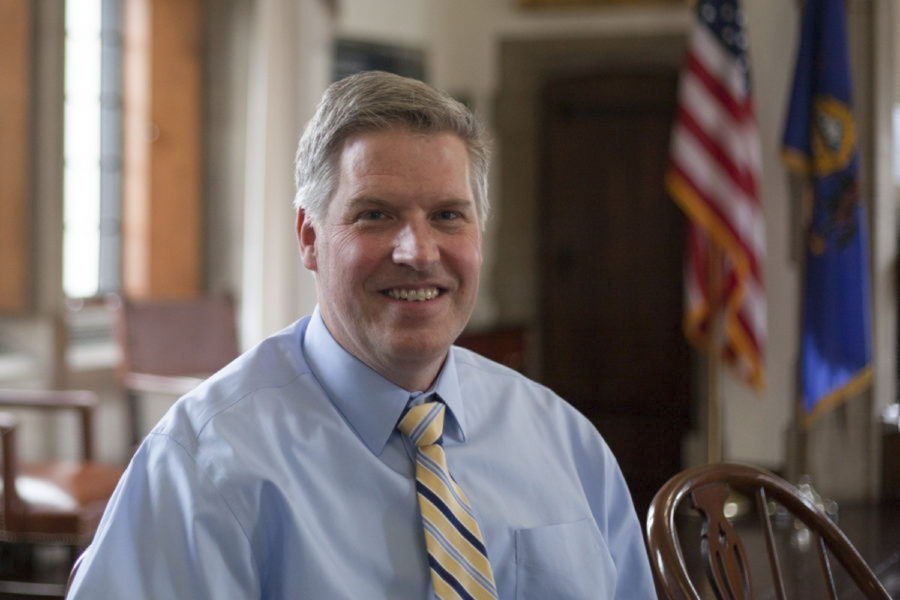Chancellor seeks state funding at Harrisburg hearing
Christian Snyder | Editor in Chief
Chancellor Patrick Gallagher testified Tuesday with executives from other state universities including Penn State, Lincoln and Temple in front of the state Senate Appropriations Committee in Harrisburg to advocate for their requested funding.
February 27, 2019
Chancellor Patrick Gallagher testified Tuesday in front of the State Senate Appropriations Committee in Harrisburg with other executives from Pennsylvania universities, hoping to increase state funding for higher education for the 2019-20 fiscal year.
He spoke as part of a panel with executives from Pennsylvania state-related universities, including Penn State, Lincoln and Temple.
State senators were largely noncommittal about the amount of money Pitt would receive for next year and spent a large portion of the hearing discussing other issues facing the University, such as student debt and establishing a panel to study Commonwealth funding to higher education institutions.
Pitt initially requested a 6.5 percent increase in funding from the Commonwealth, but the University’s funding will be held flat next year, according to Gov. Tom Wolf’s proposed budget released Feb. 5. Pitt received a 2.8 percent increase last year.
According to an analysis by the State Higher Education Executive Officers Organization, Pennsylvania offers some of the lowest financial support to higher education out of all states in the United States in 2017 at $138 per student, second only to New Hampshire at $93 per student. The national average is $289 per student.
State Sen. John Blake, D-22, asked each of the executives what the most important factor was in requesting more money than the governor had allocated.
“The request is really driven by trying to maintain or grow the state support so we can maintain affordability for Pennsylvania students,” Gallagher said.
Pitt’s initial budget request included tuition increases of about 3 percent for in-state students and 5 percent for out-of-state students, even with a solicitation for more state funding. It is unclear how tuition prices will be affected if Pitt does not receive its requested funding.
[Read: Pitt students to face tuition hike]
In an interview after Friday’s Board of Trustees meeting, Gallagher said he was unsure when tuition prices would be confirmed for next year.
“Because we’re kind of tied to when the State moves, we’ve only really, typically, been able to announce that after we know what the State has done,” Gallagher said. “Based on the discussions I’ve had with lawmakers in Harrisburg, they would love to see an on-time appropriation process.”
Commonwealth funding for state-related universities reached a low point in 2011, before starting a positive trend over the past few years. Graphic by Emily Hearty | Staff Graphic Artist
On March 26, Pitt will hold its annual Day in Harrisburg, an event where students and administration lobby state legislators for increases in funding to the University from the Commonwealth.
State Sen. Ryan Aument, R-36, who chairs the State Senate Education Committee, said he was interested in creating a higher education funding commission to reevaluate the Commonwealth’s funding methods. Pennsylvania had a similar group, the 15-member Basic Education Funding Commission, from 2014 to 2015, which recommended a formula for how to distribute state funding to K-12 school districts.
Gallagher said he was open to the idea and Pitt would be happy to participate.
“I just want to applaud the idea of the commission,” Gallagher said. “I think that all of us would welcome something looking at the portfolio of higher education programs in the Commonwealth.”
Gallagher pointed to new financial aid programs, like the Pitt Success Pell Match Program, as ways the University is trying to help students. Details about the program’s funding also surfaced for the first time during the hearing. Gallagher said money would be pulled from cost savings, existing aid reprogrammed from merit-based into need-based aid and anticipated revenue growth through increased tuition for admitted students.
[Read: Pitt to match federal Pell Grants]
“I think this correlation now between Pennsylvania offering the lowest per capita in higher ed funding on a per student basis is directly correlated with [high student debt] because the cost burden has shifted to the students and their families,” Gallagher said. “We’re trying to do as much innovation as we can, but I would agree with you this is a core problem.”








